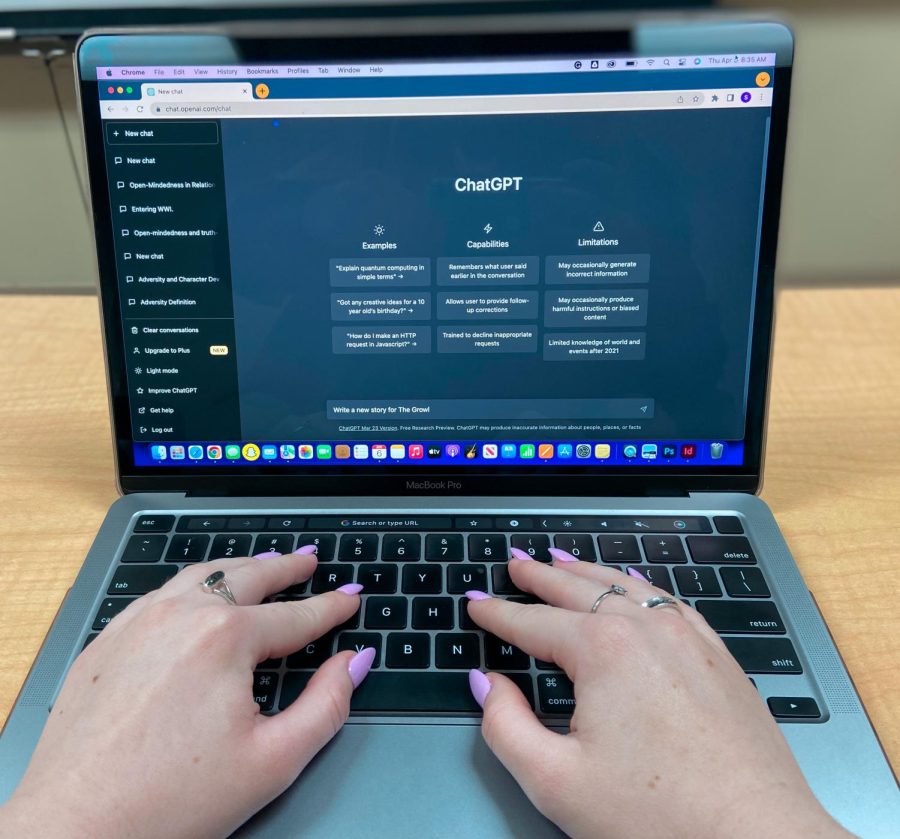An Uncertain Future
Is AI just another threat to student integrity, or the lifeline we need?
April 6, 2023
In December, Holy Trinity’s English department experienced a threat to student credibility not seen since the dawn of the internet. ChatGPT, an online chatbot that uses artificial intelligence (AI) to synthesize the web and attempt to fulfill all tasks literary, was discovered by the student body and quickly captured widespread interest and awe.
Developed by Open-AI, an AI research laboratory, ChatGPT has unprecedented capabilities even in the specialized world of secondary education. Able to write essays, craft arguments, perform research, and mold its voice to any given specifications, the software has struck a dissonant chord with many English teachers who fear that it could make current standards for detecting plagiarism seem primordial.
“ChatGPT has done for the rest of the school what Photomath did for the math department years ago,” said David Bonanza, who teaches Algebra and Statistics at HT. Many worry that the potential the program has for inconspicuous idea exchange is novel and dangerous.
Educators have watched as a digital enlightenment bloomed in academic culture following the Covid-19 pandemic. Sarah Brown, an AP English Literature and Composition teacher at HT, has embraced this new trend and spent the last three years converting her class to “entirely online—that means all the readings are online, we’ve annotated online, we’ve written essays online,” said Brown.
While this digital approach broadens accessibility, it is now threatened by AI writing assistants like ChatGPT. Before these tools were available, student plagiarism was usually detectable through software like Turnitin. AI content, however, is traceable by spotting copied patterns—not copied words—which is currently difficult to achieve even with specialized software. Because student integrity is valued so highly at HT, ChatGPT could stunt the growth of our budding digitally accessible academic world if it proves a tool used only for cheating.
“I think it will take the educational community time to process exactly what ChatGPT means for education specifically, and for that reason, in the meantime I’m shifting back to pen and paper,” said Brown. “At least until we figure out a sustainable way to potentially incorporate it or software that can identify it,” she added.
The professional world, like its academic precursor, is also struggling to adapt with and accept the new technology. While some more innovative industries are welcoming the new aid, others, especially more orthodox branches like the medical and legal fields that prefer to stand firmly on experience, are worried about false authorship and erroneous publications. Though reactions vary, many believe that ChatGPT will somehow become an integral part of our future labor system.
When new applications of AI are made public, “a lot of people go and either dismiss it or go into panic mode thinking that we’re all doomed, it’s going to be a Terminator situation… I don’t think either are realistic,” said Bonanza. He believes that this developmental bloom of AI machines, which he emphasizes is not limited to but far beyond ChatGPT, is a new stage for the state of the professional realm. “I can’t imagine a world in which people stop using it in this competitive world. If something makes you dramatically more efficient and productive, people are going to find a way to keep using it,” he said.
It is the role of education to prepare students for this world, so many teachers are grappling with the obligation to teach this novel technology while staying cognizant of its potential for abuse. Sommer McDonald, who teaches English, Writing Composition and Capstone Seminar, believes that “the way to deal with new technology that can be assitive to students is to teach them how to use it.” She emphasized that teachers should make a distinction between the use of assistive AI “in constructive ways” as opposed to “just using it to do the work for them.”
She sees benefit in ChatGPT’s ability to synthesize information concisely. “I think that for editing purposes it would be great,” she said. Her classes, like most at HT that involve proofreading and citation, already utilize other writing tools like Grammarly and EasyBib. Like these technologies, ChatGPT could potentially “be used to help check their work,” said McDonald.
Because ChatGPT has abilities far beyond those of simple grammar-check aids like Grammarly, some educators worry that the tool would act less as a helping hand and more as a substitute in situations that are crucial to develop critical thinking skills. However, Carinn Mariani, who teaches English Language and Capstone Seminar, argues that if students are correctly taught how to use assistive AI, then critical thinking skills are not eliminated but adapted. She has already taught one lesson in her AP English Language and Composition class that emphasized the importance of educated input when students use the software.
When students were asked to grade its response to a given prompt by the AP rubric, “they all gave it a mediocre score, which is what it was,” said Mariani. This lesson taught students the software’s limitations, like its lack of in-text evidence and recent knowledge. How did they improve the result? “We altered the prompt,” she said, drawing from knowledge of the rubric, the prompt’s context, and the assignment’s criteria to generate a better response.
This process “is what ChatGPT is meant to do,” Mariani explained. “It’s meant to be a conversation to get to somewhere better and more complex.” For that reason, teaching ChatGPT would still allow students to use critical thinking because it is founded on the expectation that users understand the context and reasoning behind their prompts. “If you don’t know the questions because you have a very limited knowledge base, you can’t go any deeper,” she said.
The use of ChatGPT during assessments, when these skills must be tested, is currently restricted, though some teachers have already seen submitted work affected by the software. “Something that is just typed in and printed out, you can spot it pretty easily,” said McDonald. ChatGPT struggles to imitate the unique “voice” with which students write. “When you get something that’s been written by AI, it doesn’t have that same human element, that same voice, that same teenager angle,” she said.
Brown argues that the key piece missing in AI-generated responses is “creativity” because it acts like “a calculator for writing.” AI work has “good syntax, sentence structure, vocabulary, grammar, spelling,” said Brown but leaves “gaps in logic when it tries to connect commentary and evidence,” a technique used heavily in HT’s high-caliber English classes.
Though HT’s English teachers hold various perspectives on the future of ChatGPT in the classroom, the College Board has already stifled the conversation regarding official AP work. Immediately after ChatGPT was made public, the program declared that all students are “prohibited from using any and all Artificial Intelligence tools… to guide, brainstorm, draft, or create student work related to any AP assessment.”
To what extent ChatGPT will be allowed and taught in the classroom outside of assessments is still undecided. What is known is that the technological world is developing rapidly, and its tendrils are reaching to the ends of the professional world. Secondary education, however, has always been averse to change, yet it is crucial that among its consequences is professional preparation. HT is therefore nestled into a paradox, asked to teach innovation without letting its lessons welcome an age of plagiarism and deceit. How AI will change how we work, teach, learn, and stay true to our integrity, remains to be seen.

